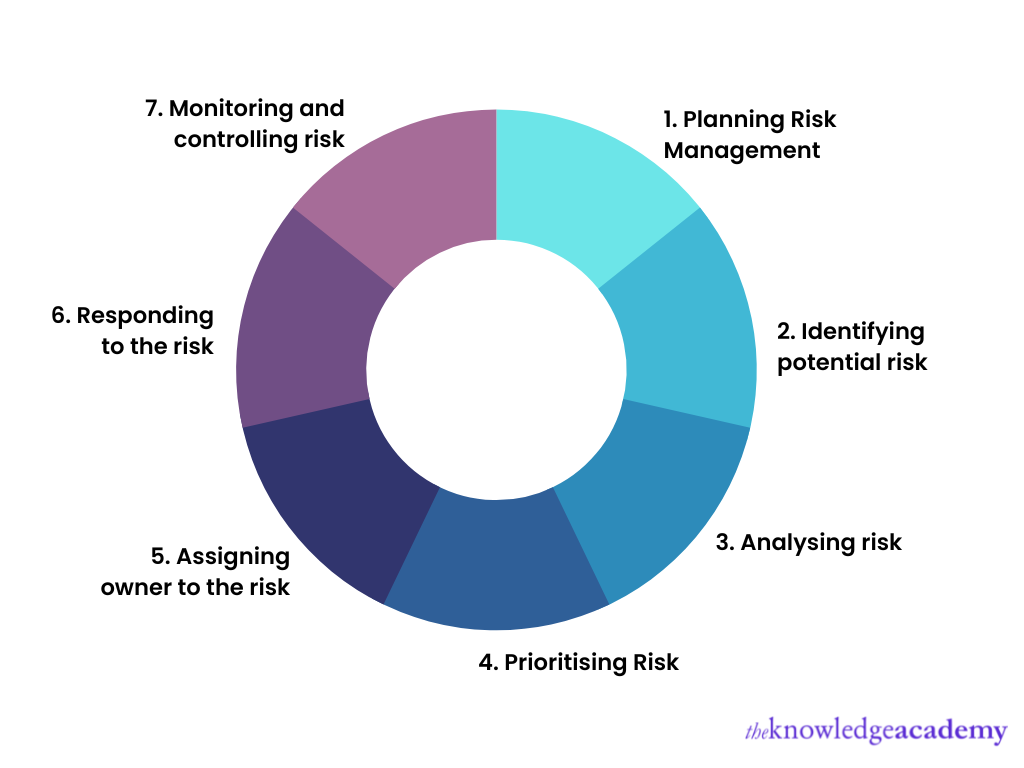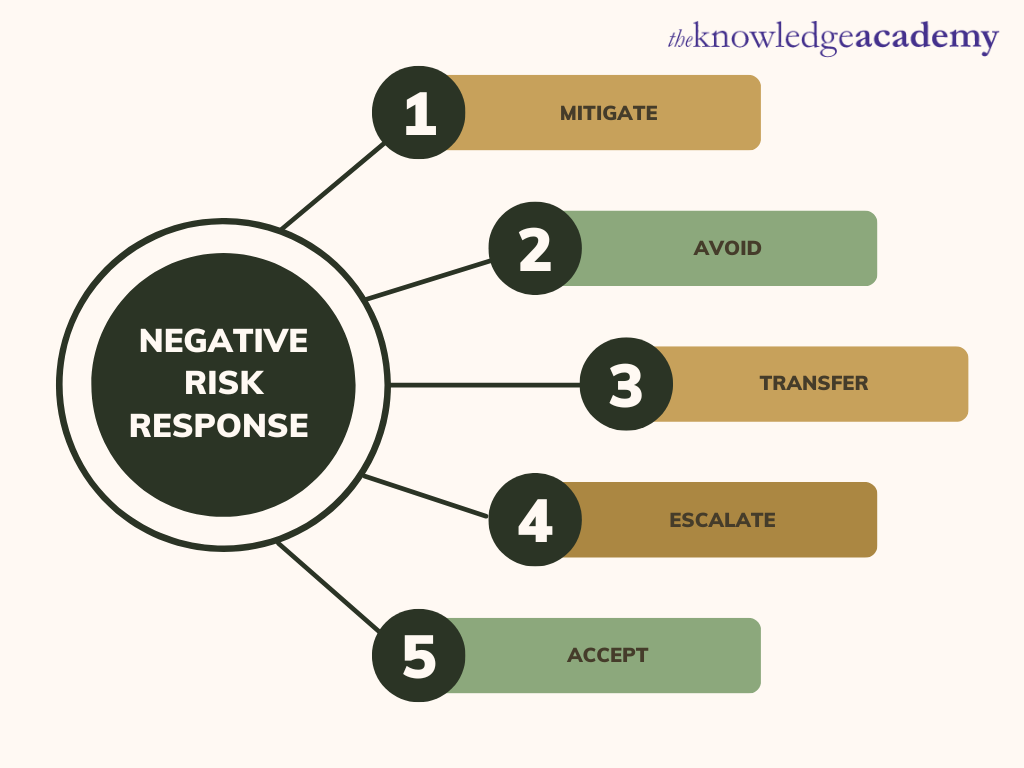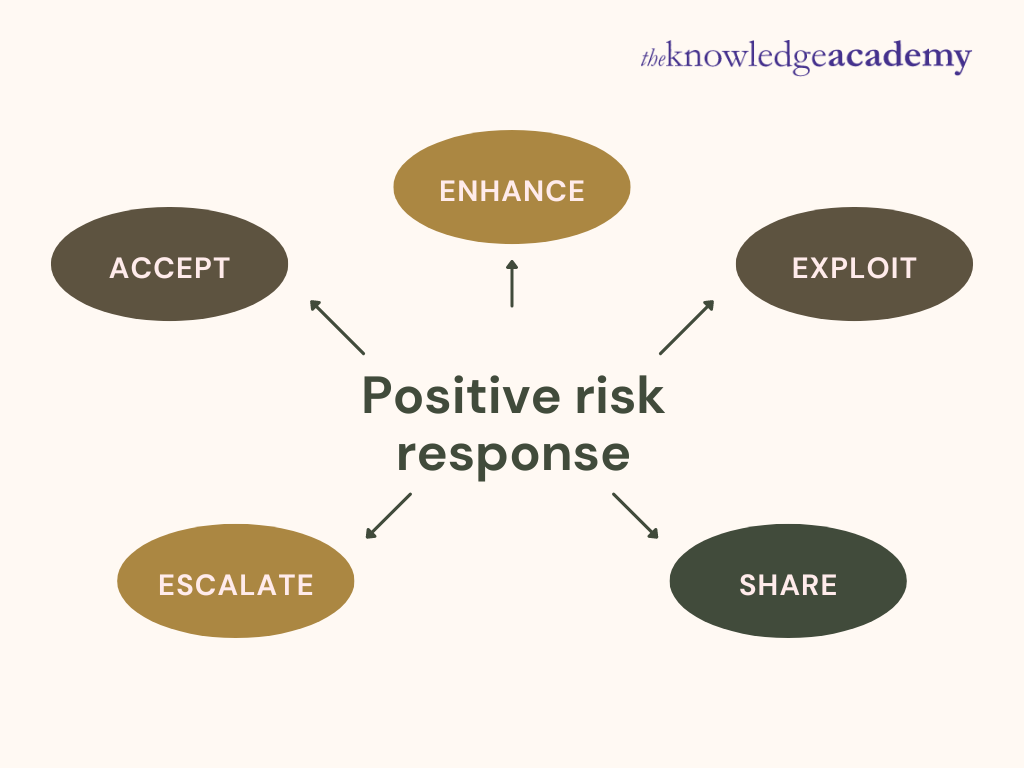We may not have the course you’re looking for. If you enquire or give us a call on 01344203999 and speak to our training experts, we may still be able to help with your training requirements.
Training Outcomes Within Your Budget!
We ensure quality, budget-alignment, and timely delivery by our expert instructors.

Projects always have unexpected issues and risks that are inevitable. Thus, as a Project Manager, it is your job to identify risks and develop a PMP Risk Management plan to overcome unforeseen adversities in a project. It helps the Project Manager and the project team to carry out Risk Management activities without any hassle. Also, this type of thinking is just being cautious. If you are Project Management Professional (PMP) credential holder, you know that the PMP exam tests your knowledge of Risk Management. Otherwise, inefficient Project Management processes cause nearly 12% wastage of organisational resources. process PMP Risk management is the process of identifying project risks, planning, monitoring, and managing projects in Project Management to give the perfect outcomes.
In this blog, we will understand all the elements of a Risk Management plan. This will help Project Managers prepare their risk mitigation plans and be helpful if you’re a PMP aspirant.
Table of Contents
1) What is PMP Risk Management Process?
a) Why should you track risk in projects?
b) How to go about managing risk?
2) What is Positive Risk?
3) What are the seven elements of Risk Management Process?
4) Tools and techniques needed in Project Risk Management
5) Key deliverables for Project Risk Management
6) Conclusion
What is PMP Risk Management Process?
The Risk Management process deals with preparing for resolving unknown issues. Risks are an inherent part of any Project Management task. Risks can arise anytime in the Life Cycle of projects that can affect the project schedule, cost, and resources. Risks can be addressed by developing a detailed Risk Management plan. The Project Managers should be capable of proactively predicting, assessing and resolving the issues/risks in the project.
Why should you track risk in projects?
The impact of the risk on a project is strongly correlated with its scope and complexity. The Project Management Team, including Project Managers, are responsible for tracking risks on time. So, they can develop corresponding mitigation or response plans to these issues and reduce the negative impacts on the project. When the team follows for risks, they can also come across positive risks that are not harmful to the project but beneficial. A Risk Management plan will help you identify and take advantage of positive risks.
Risk tracking is performed so the Project Management Team can respond effectively and may make the necessary corrections. They can also ensure that the lessons learned can be utilised in future projects. You should understand that effective Risk Management can make a project successful or fail. Tracking risks beforehand will ensure the maximum success of a project.
How to go about managing risk?
Risk Management in Projects deals with identifying, analysing, prioritising and mitigating risks. You have to ensure that you identify risks at each phase of the project. To begin with, managing risks, you must clearly define the expected project deliverables. Develop an extensively detailed project charter that should include project vision, objectives and goals, scope and deliverables.
Then get your entire Project Management Team to identify every risk and prioritise risks, too. You can get the whole project team, stakeholders and sponsors to plot risks to the project. It would help if you documented their input about what they think may go wrong on the project. Make sure to document all the risks that have been predicted and asses the priorities of the risks. Then develop a Risk Management plan to document the pros and cons of the risks to the project, and the mitigation plans to reduce their impact. Set up regular meetings with the team to monitor risks during the project life cycle.
Make sure to document all the risks that have been predicted and asses the priorities of the risks. Then develop a Risk Management plan to document the pros and cons of the risks to the project, and the mitigation plans to reduce their impact. Set up regular meetings with the team to monitor risks during the project life cycle.
Learn Risk Management from a PMI-authorised training partner. Sign up for PMI Risk Management Professional!
What is Positive Risk?
Most People associate risk with a harmful mishap; however, that is not always true. While negative risks are unforeseen and unwanted with a tendency to damage a project; on the other hand, positive risks are beneficial, providing new opportunities to enhance the quality of the project. Thus, it is essential to take advantage of a project's opportunities to improve project quality and deliver faster with effective resource management.
For example, you can be consistent with a project rather than just delaying it so that a quick delivery might open up possibilities for a better impression in the market. But these positives can also turn into adverse risks and vice-versa if not appropriately planned with Risk Management strategies.
While a Project Manager plans and strategies a project, it is also essential to know how to handle and balance positive and negative risks and make the most of them.
What are the seven elements of Risk Management Process?
The Risk Management process must be tailored to meet the requirements of each unique project. A well-developed Risk Management plan will include how to identify risk, analyse risk, measure risk and mitigation strategies. Let's discuss in detail the steps you need to follow for project Risk Management. Project Managers across industries follow these steps to turn disadvantages into advantages.

1) Planning Risk Management
2) Identifying potential risk
3) Analysing risk
4) Prioritising Risk
5) Assigning owner to the risk
6) Responding to the risk
7) Monitoring and controlling risk
1) Planning Risk Management
This process deals with developing a document that describes the details of how Risk Management will be done. This document will define the responsibilities of the Project Management Team to deal with positive and negative risks.
It will also include a budget and resources for managing risks, risk tolerance level, identifying and categorising risks, and implementing risk responses. In addition, this plan will also include the formula to determine the ranking of the risks as high, medium or low. The more complex the project, the broader the Risk Management plan.
2) Identifying potential risk
Risk identification is crucial, especially when managing large or complicated projects, since it forms the basis for tools like the risk matrix and risk assessment methods. You can gather risks during this phase using the techniques outlined in the Risk Management plan. Several methods for identifying risks include:
1) Reviewing documents – Careful review of the documents from previous project records like learned lessons, risk register, issue log and project files. This will help you detect any potential risk in the current project.
2) Information gathering – As mentioned earlier take the inputs from the project team and various stakeholders involved in the project. You ask specialists to identify potential risks. This method combines the Delphi method, anonymous questionnaire and brainstorming. Compile all the inputs and review them thoroughly.
3) Interview – You can take the help of pre-developed questions to get inputs from busy stakeholders by conducting a single interview with them.
Additionally, conduct a careful review of project objectives. Each identified risk is classified on the risk register by several elements (such as internal or external triggers) or by categories (such as environmental, regulatory, technological, or resources).
Want to gain a certification that demonstrates your Project Management skills and experience? Sign up for PMP Certification Training!
3) Analysing risk
After identifying the potential risks, you need to analyse these risks using quantitative and qualitative methods. Qualitative and quantitative risk analysis can ascertain how the risk will affect the project schedule and budget.
a) Quantitative risk analysis – Quantitative analysis of risks is mainly performed on large and complex projects to assign numerical values to the level of risk on the project objective. Quantitative risk analysis gives numerical values to each identified risk using "hard" data, such as costs, operations, and the number of resources involved. The Expected Monetary Value (EMV) Method is used to determine the contingency reserve, to manage each identified risk.
b) Qualitative risk analysis – Using a relative scale, you can perform qualitative risk analysis by calculating each risk's likelihood and potential impact. This helps determine the priority of resolving the risks. Qualitative analysis is performed for each risk and not the overall project risk. The accuracy of this analysis depends on the knowledge of the individual doing the qualitative risk analysis.
For accuracy, Project Managers should conduct both qualitative and quantitative risk analysis. In addition, the management sets a reserve for managing unidentified risks, usually between 5 to 10 per cent. The Project Manager needs to get the approval of the management to use this reserve.
4) Prioritising Risk
It is essential to assess the priorities of the risks identified to determine what resources you will require to resolve the risk, as the complexity of all risks is not the same. You can make a long list of risks to a project by classifying them as high, medium and low. Based on this, you decide when and how to address each risk during the project life cycle.
High-level risks need immediate action, as they may make or break your project. Medium-level risks might be essential but will next fail the project. You can set these risks as the next priority after high-level risks. At last, some risks might be crucial but do not need more time to resolve. These are low-level or low-priority risks.
5) Assigning the owner to the risk
The Project Manager must assign risks to individual team members to oversee particular risks when listing the risks. This individual has to be more skilled and experienced in Risk Management than others in the project team.
Secure your future in Project Management! Check out our Project Management courses!
6) Responding to the risk
Along with the risk owner, you need to put together the mitigation strategy for minimising the impacts of the risk. You will respond to the risks based on the priorities you have set for the risks identified. This mitigation plan should describe your actions when these risks occur in the project life cycle.
First, you must determine if the risks are positive or negative, as they will require separate strategies. Positive risk can help the project, whereas adverse risk might hinder it.
Negative risk response – the strategies to manage negative risks include:

1) Mitigate – try to decrease the chances of this risk occurring or if it does try to reduce its impact.
2) Avoid – Eliminate the risk or its consequences, by modifying the project’s strategic plan.
3) Transfer – You can transfer this risk to a third party like an insurance company.
4) Escalate – handover the responsibility of managing this risk to the higher management, as it is beyond the Project Manager’s capabilities.
5) Accept – You document the risk
Positive risk response - the strategies to manage positive risks include:

1) Enhance – try to increase the chances of this risk occurring or its impact.
2) Exploit – working to ensure this opportunity is realised
3) Share – if one person cannot realise this opportunity share it with someone else
4) Escalate - handover the responsibility of managing this risk to the higher management, as it is beyond the Project Manager’s capabilities.
5) Accept - You document the risk
7) Monitoring and controlling risk
You have to track the initiative taken against improving or mitigating risks. The Project Manager must monitor risk to ensure the proper steps are carried out as quickly as possible for the most significant impact. Whoever is the risk owner will be in charge of monitoring risk and how it is being resolved. A strategy for monitoring and reporting risk events is part of the Risk Management plan. This aids the Project Manager lessons learned for potential future risk incidents and evaluating the effectiveness of the Risk Management plan.
Also, check out our blog to learn about PMBOK Guide!
Tools and techniques needed in Project Risk Management
Risks are inherent to a project. But mitigating them should also be a part of the Risk Management process. There are several PMP tools and techniques that an organisation can implement as a part of their Project Management process. Let's find out what these are:
1) Brainstorming – Brainstorming involves collectively planning and preparing a framework by the Project Manager and the team. This includes reviewing documentation, overviewing the risks involved in previous projects and learning from them, and understanding organisational process assets.
2) Root cause analysis – This technique helps identify risks inherent in the project. As soon as any problem arises, the team delves into the root cause of the problem and solves it then and there.
3) SWOT Analysis – SWOT means approaching to Strengths, Weaknesses, Opportunities and Threats of the project. It helps in the overall nature of the project. While you can spot the strengths and opportunities and turn them into positive risks, threats and weaknesses will help you recognise where the project lacks and work on them.
4) Risk data quality assessment – The method provides the Project Manager with an understanding of the risks involved in the project and collects information about the possible risks. It is done by collecting data for identified risks and finding details about possibly harmful risks.
5) Probability and impact matrix – This tool helps in prioritise risks based on their probability to harm. Project Manager prepares a plan where the risks are calculated and ranked based on their seriousness to harm.
6) Reserve analysis – This includes keeping reserves and contingency measures while planning the project budget. This step is essential to have a backup and secure the project stages from unwanted risks.
Build your career as a Project Management Professional (PMP).
Register in our PMP Training today!
Key deliverables for Project Risk Management
The Project Management key deliverables include:
1) Risk management plan – This document is prepared by the project to predict and evaluate the impact of risks and define responses to risks.
2) Risk register – This means the Risk Log, another document developed in the initial stages of the project. It helps in identifying issues and mitigating them as soon as they arise.
Also, check out our blog to prepare the top PMP exam questions to crack the exam!
Conclusion
Your project's success depends on the PMP Risk Management plan you develop. A good plan will help you complete the project on time and within your budget. Take the help of seven elements of the Risk Management process to design a tailored Risk Management plan for your project.
Start your preparation here – sign up for the Introduction to Project Management course!
Frequently Asked Questions
Upcoming Project Management Resources Batches & Dates
Date
 PMP® Certification Training Course
PMP® Certification Training Course
Mon 29th Jul 2024
Mon 5th Aug 2024
Sat 10th Aug 2024, Sun 11th Aug 2024
Mon 12th Aug 2024
Mon 19th Aug 2024
Sat 24th Aug 2024, Sun 25th Aug 2024
Tue 27th Aug 2024
Mon 2nd Sep 2024
Sat 7th Sep 2024, Sun 8th Sep 2024
Mon 9th Sep 2024
Mon 16th Sep 2024
Sat 21st Sep 2024, Sun 22nd Sep 2024
Mon 23rd Sep 2024
Mon 30th Sep 2024
Sat 5th Oct 2024, Sun 6th Oct 2024
Mon 7th Oct 2024
Mon 14th Oct 2024
Sat 19th Oct 2024, Sun 20th Oct 2024
Mon 21st Oct 2024
Mon 28th Oct 2024
Sat 2nd Nov 2024, Sun 3rd Nov 2024
Mon 4th Nov 2024
Mon 11th Nov 2024
Sat 16th Nov 2024, Sun 17th Nov 2024
Mon 18th Nov 2024
Mon 25th Nov 2024
Sat 30th Nov 2024, Sun 1st Dec 2024
Mon 2nd Dec 2024
Mon 9th Dec 2024
Sat 14th Dec 2024, Sun 15th Dec 2024
Mon 16th Dec 2024
Mon 6th Jan 2025
Mon 13th Jan 2025
Mon 20th Jan 2025
Mon 27th Jan 2025
Mon 3rd Feb 2025
Mon 10th Feb 2025
Mon 17th Feb 2025
Mon 24th Feb 2025
Mon 3rd Mar 2025
Mon 10th Mar 2025
Mon 17th Mar 2025
Mon 24th Mar 2025
Mon 31st Mar 2025
Mon 7th Apr 2025
Mon 14th Apr 2025
Tue 22nd Apr 2025
Mon 28th Apr 2025
Tue 6th May 2025
Mon 12th May 2025
Mon 19th May 2025
Tue 27th May 2025
Mon 2nd Jun 2025
Mon 9th Jun 2025
Mon 16th Jun 2025
Mon 23rd Jun 2025
Mon 30th Jun 2025
Mon 7th Jul 2025
Mon 14th Jul 2025
Mon 21st Jul 2025
Mon 28th Jul 2025
Mon 4th Aug 2025
Mon 11th Aug 2025
Mon 18th Aug 2025
Tue 26th Aug 2025
Mon 1st Sep 2025
Mon 8th Sep 2025
Mon 15th Sep 2025
Mon 22nd Sep 2025
Mon 29th Sep 2025
Mon 6th Oct 2025
Mon 13th Oct 2025
Mon 20th Oct 2025
Mon 27th Oct 2025
Mon 3rd Nov 2025
Mon 10th Nov 2025
Mon 17th Nov 2025
Mon 24th Nov 2025
Mon 1st Dec 2025
Mon 8th Dec 2025
Mon 15th Dec 2025







 Top Rated Course
Top Rated Course



 If you wish to make any changes to your course, please
If you wish to make any changes to your course, please


